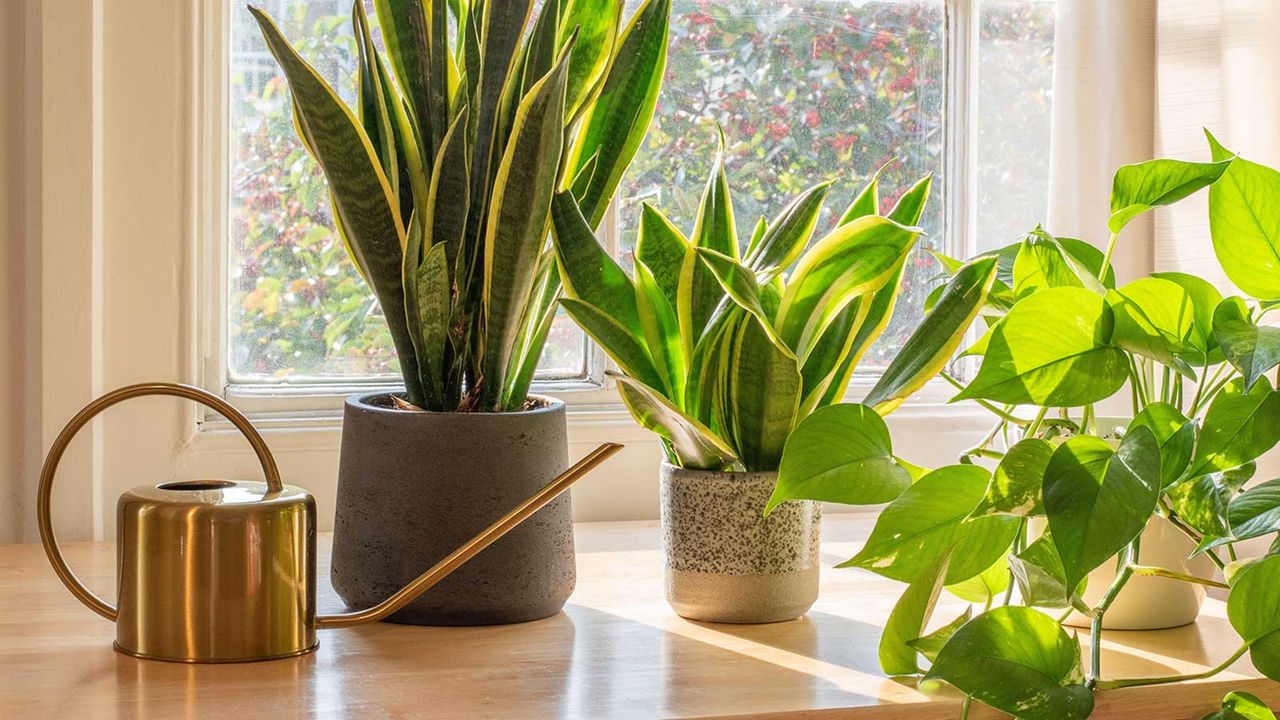How Often to Water Snake Plants for Maximum Growth is a question that often arises for plant enthusiasts. Snake plants, known for their resilience and adaptability, are a popular choice for indoor spaces. Understanding their watering needs is crucial for their thriving.
This guide delves into the essential aspects of snake plant hydration, providing a comprehensive overview of watering frequency, techniques, and troubleshooting tips to ensure optimal growth and a flourishing plant.
Snake plants, scientifically known as Sansevieria, are native to arid and semi-arid regions of Africa and Asia. These hardy plants have evolved to thrive in environments with limited water availability, making them remarkably drought-tolerant. However, while they can withstand periods of dryness, consistent hydration is essential for their long-term health and growth.
Overwatering, on the other hand, can be detrimental, leading to root rot and other problems. Understanding the signs of proper hydration and the factors influencing watering frequency is key to cultivating a thriving snake plant.
Understanding Snake Plant Watering Needs: How Often To Water Snake Plants For Maximum Growth
Snake plants, also known as Sansevieria, are renowned for their resilience and adaptability. Their ability to thrive in a variety of conditions, including neglect, makes them a popular choice for beginner plant owners. However, understanding their watering needs is crucial for ensuring optimal growth and preventing problems.
Natural Habitat and Water Requirements
Native to dry, rocky regions of Africa, snake plants have evolved to withstand long periods of drought. Their natural habitat features minimal rainfall and well-draining soil. This adaptation explains their remarkable drought tolerance. In their natural environment, they receive water primarily from infrequent rainfall, relying on their thick, succulent leaves to store moisture.
Drought Tolerance Mechanisms, How Often to Water Snake Plants for Maximum Growth
Snake plants possess several unique characteristics that contribute to their drought tolerance:
- Thick, Succulent Leaves:These leaves act as water reservoirs, storing moisture for extended periods.
- Shallow Root System:Their shallow roots enable them to quickly absorb water from infrequent rainfall or watering events.
- Waxy Leaf Coating:This coating helps reduce water loss through transpiration, minimizing the need for frequent watering.
Consequences of Overwatering
While snake plants are remarkably drought-tolerant, overwatering can lead to serious problems, including:
- Root Rot:Excessive moisture creates an environment conducive to fungal growth, which can damage and rot roots.
- Yellowing Leaves:Overwatering can cause leaves to turn yellow and limp, indicating root stress.
- Leaf Drop:In severe cases, overwatering can lead to leaf drop, weakening the plant.
Signs of Proper Hydration

A healthy snake plant is a testament to proper watering practices. Observing the plant’s visual cues and assessing the soil moisture level can help you determine if your snake plant is adequately hydrated.
Visual Cues of Proper Hydration
A well-hydrated snake plant exhibits specific visual characteristics. These signs provide valuable insights into the plant’s overall health and hydration status.
- Firm and Upright Leaves:Healthy snake plant leaves are firm to the touch and stand erect, showcasing their natural upright growth habit. The leaves should not be limp or drooping, indicating adequate moisture content.
- Vibrant Leaf Color:Proper hydration contributes to the snake plant’s vibrant leaf color. Look for rich green hues with no signs of yellowing or browning, which can indicate overwatering or underwatering.
- Absence of Wilting:Wilting leaves are a clear sign of dehydration. If the leaves are drooping or losing their firmness, it’s a signal that the plant needs water. However, it’s important to note that occasional drooping, especially in the evening, can be a natural response to light changes and does not necessarily indicate dehydration.
Assessing Soil Moisture
The soil’s moisture level is a crucial indicator of whether the snake plant needs water.
While snake plants are known for their resilience, proper watering is key to maximizing their growth. Like bonsai trees, which require careful selection of pots to manage their roots and promote healthy development, snake plants benefit from containers that allow for good drainage.
Bonsai Pot Designs: Choosing the Best for Indoor Trees can offer valuable insights into choosing the right pot for snake plants, ensuring their roots are not waterlogged and encouraging healthy growth. This focus on drainage and the right pot is crucial for both snake plants and bonsai trees, ultimately contributing to their overall health and flourishing.
- Finger Test:Insert your finger about 2-3 inches into the soil. If the soil feels dry, it’s time to water. If the soil is still moist, wait a few days before watering again.
- Weight Test:Lift the pot to gauge its weight. A dry pot will be significantly lighter than a moist pot. This method can be particularly helpful if you have a large snake plant or a heavy pot.
- Moisture Meter:A moisture meter can provide a more precise measurement of the soil’s moisture content. Insert the probe into the soil and follow the meter’s instructions for reading the moisture level.
Environmental Factors Affecting Watering

Understanding the environment your snake plant lives in is crucial for determining its watering needs. Factors like light exposure, temperature, and humidity can significantly impact how often you need to water your plant.
Light Exposure and Water Consumption
Light intensity directly affects a snake plant’s water consumption. Plants in bright, indirect light will transpire more water, leading to increased water needs. Conversely, snake plants in low light conditions will have a slower rate of transpiration, requiring less frequent watering.
Optimal Temperature and Humidity Levels
Snake plants thrive in temperatures between 65°F and 85°F (18°C to 29°C). At these temperatures, the plant’s metabolic processes are active, and it will need regular watering to maintain proper hydration. However, in colder temperatures, the plant’s metabolic rate slows down, requiring less frequent watering.
Snake plants are relatively tolerant of low humidity levels. However, optimal humidity levels for snake plant growth are between 40% and 60%. When humidity is low, the plant may lose more water through transpiration, necessitating more frequent watering.
Just like understanding how often to water snake plants for maximum growth, selecting the right pot for your bonsai tree is crucial for its health and aesthetics. The right pot not only enhances the tree’s beauty but also helps regulate its growth and moisture levels.
To learn more about choosing the perfect pot for your bonsai, check out this helpful guide: How to Choose a Bonsai Pot That Suits Your Tree’s Needs. Similarly, when it comes to snake plants, the key to success lies in finding the right watering frequency that balances moisture and prevents root rot.
Troubleshooting Watering Issues
Even with careful attention to watering schedules, snake plant owners may encounter issues. Understanding the signs of overwatering and underwatering is crucial for correcting mistakes and reviving a stressed plant.
Identifying and Addressing Common Watering Problems
Overwatering and underwatering are the most common watering problems faced by snake plant owners. Both can lead to various symptoms, and it’s important to identify the issue correctly to provide the appropriate solution.
Signs and Symptoms of Overwatering
Overwatering occurs when the soil remains too moist for extended periods. This can lead to root rot, a condition that prevents the roots from absorbing water and nutrients.
- Yellowing Leaves:Overwatering often causes leaves to turn yellow, especially at the base of the plant. This is a sign of root damage and nutrient deficiency.
- Soft or Mushy Leaves:If the leaves feel soft or mushy, it indicates that the plant is retaining too much water. This can also lead to a foul odor from the soil.
- Drooping Leaves:While drooping leaves can also indicate underwatering, they can also be a sign of overwatering, especially if the leaves are also yellow or soft.
- Brown or Black Spots:Overwatering can cause brown or black spots on the leaves, indicating fungal infections. These spots may appear on the tips or edges of the leaves.
Signs and Symptoms of Underwatering
Underwatering occurs when the soil dries out too much, depriving the plant of essential moisture. This can lead to dehydration and stress.
- Wilting Leaves:Underwatered snake plants will have wilting leaves that droop and become limp. This is a clear sign that the plant needs water.
- Dry and Crispy Leaves:If the leaves are dry and crispy, it indicates that the plant has been underwatered for a long time. These leaves may not recover.
- Brown Leaf Tips:Underwatering can cause the tips of the leaves to turn brown and dry. This is a common sign of dehydration.
- Slow Growth:Underwatering can hinder the plant’s growth, as it lacks the moisture needed for proper development.
Solutions for Correcting Watering Mistakes
Once you identify the watering problem, it’s essential to take corrective measures to revive your snake plant.
Reviving an Overwatered Snake Plant
- Repotting:Remove the plant from its pot and inspect the roots. Trim away any rotten or mushy roots with sharp, clean scissors. Repot the plant in fresh, well-draining potting mix.
- Allow Soil to Dry:After repotting, allow the soil to dry out completely before watering again. This will help prevent further root damage.
- Reduce Watering Frequency:Once the plant has recovered, reduce the watering frequency to prevent overwatering in the future. Allow the top inch of soil to dry out before watering again.
Reviving an Underwatered Snake Plant
- Thorough Watering:Water the plant thoroughly until water drains out of the drainage holes. This will ensure that the roots are fully hydrated.
- Regular Watering:Establish a regular watering schedule and monitor the soil moisture. Allow the top inch of soil to dry out before watering again.
- Humidity:Increase the humidity around the plant by placing it on a pebble tray filled with water or using a humidifier. This will help prevent the leaves from drying out.
Conclusion
Watering snake plants effectively is a balancing act, requiring an understanding of their natural needs and the environmental factors that influence their hydration. By observing the visual cues, assessing soil moisture, and adhering to the watering guidelines, you can ensure that your snake plant receives the appropriate amount of water for optimal growth.
Remember, consistent hydration is essential for their well-being, but overwatering can be detrimental. With a little knowledge and care, you can nurture a thriving snake plant that will add beauty and life to your indoor space.
Answers to Common Questions
What are the signs of overwatering a snake plant?
Overwatered snake plants often exhibit yellowing leaves, mushy stems, and a foul odor. The soil may remain consistently wet, and you might notice mold growth on the surface.
How can I revive an underwatered snake plant?
To revive an underwatered snake plant, thoroughly water it and allow the soil to dry out completely between waterings. You can also mist the leaves with water to increase humidity. With proper care, the plant should recover within a few weeks.
Can I use tap water to water my snake plant?
While tap water is generally suitable for watering snake plants, it’s best to let it sit for 24 hours before using it. This allows the chlorine to evaporate, which can be harmful to plants.
What is the best type of pot for a snake plant?
Terracotta pots are ideal for snake plants as they allow for better drainage and prevent overwatering. Plastic pots can also be used, but ensure they have drainage holes.
